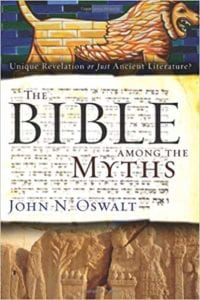[Originally published as Book Review: The Bible Among the Myths]
It is common today for many to dismiss the claims of the Bible on the basis of the long-disproven claims of its neighbors. Of course, this causes one to wonder why the biblical worldview has persisted for so long!
Old Testament scholar John Oswalt delivers a much-needed and thoroughgoing treatment of a difficult and important topic today: The Bible Among the Myths.
Within the pages of this book, Oswalt gives us helpful insight into the world of the Bible and the worldview of the Hebrews — and successfully shows that where similarities abound, differences much more abound!
Book Summary
 Dr. Oswalt argues convincingly that, although there are numerous similarities between the Bible and the religious works of other ANE cultures, such similarities are vastly outnumbered by the differences.
Dr. Oswalt argues convincingly that, although there are numerous similarities between the Bible and the religious works of other ANE cultures, such similarities are vastly outnumbered by the differences.
Ancient Near Eastern cultures viewed the world from a position of continuity, that is, the world is “god” and “god” is the world. There is no clear line of demarcation between the natural and the divine.
For the Hebrews, however, God is “transcendent,” that is, he is the Creator of the world and is radically other than the world. Thus, on any reasonable definition of myth, the Bible cannot be considered mythical.
Oswalt argues that the Israelite concern for accurate historical recording is clear evidence that they truly believed God acted in history, and that their past and present choices meaningfully affected their future in a way that is impossible on a worldview of “continuity.”
Material Review
One of the first and most important insights to be gleaned from the book is how recent this way of comparing the Bible with its mythical “counterparts” actually is.
And, perhaps even more significant, how this change has not been brought about by the discovery of new evidence but by a philosophical shift in the literature.
The book is well-written. Dr. Oswalt is well-known for his Old Testament work, especially with respect to the concept of “holiness.” He is not only a well-spoken author but also a humble one. Oswalt makes no attempt to jab at those who disagree, nor does he critique their views without ample caveat.
Certainly, there are issues on which I disagree with the author. I’ll mention these as part of my closing remarks. All in all, however, Oswalt’s persuasive demeanor, obvious attention to detail, and careful historical research contribute to the success of this important work.
Key Insights
- The authors of the Old Testament viewed the world much differently than their ANE neighbors.
- The biblical worldview is necessary to make sense of logic, reason, etc. Even secular philosophers today recognize that the biblical worldview gave us the tools necessary to develop such disciplines as science and philosophy.
- “The unique linkage of Greek and Israelite thought led to several characteristic features of Western civilization. Included among these are:
the validity of reason, the importance of history, the worth of the individual, and the reality of nature.
But in the revolt of the Enlightenment against what it saw as the stultifying strictures of Christian dogma, these and other results were made ultimate values.” - Most definitions of the word “myth” are not comprehensive and meaningful enough to make helpful distinctions.
- The author defines myth as “a form of expression, whether literary or oral, whereby the continuities among the human, natural, and divine realms are expressed and actualized. By reinforcing these continuities, it seeks to ensure the orderly functioning of both nature and human society” and remarks that “If this definition is accepted, then it must be abundantly clear that whatever the Bible is, it is not myth. It is not a question of the Bible being true and myth being false, or vice versa.”
- The mythical ANE worldviews all share one common thread, continuity: “all things that exist are physically and spiritually part of one another. This is the single most important aspect of the way of thinking that characterizes myth.”
- The continuity worldview, by necessity, neglects the concept of “choice.” If there is no clear distinction to be made between myself and others, then choices are irrelevant: “We do things for reasons that we do not understand, and we experience results that often seem to have little relationship to what we did or chose to do. So we feel that our actions have little bearing on the real outcome of things.”
- The biblical worldview is shrouded with transcendence: “God is not the world, cannot be identified with the world, and cannot be manipulated through the world.”
- The difference between the biblical worldview and all others is so significant that there are only three religions in the world today that derive from it: Judaism, Christianity, and Islam—all of which derive this idea from the Bible.
- For obvious reasons, the idea of “continuity” explains why mythical worldviews place such emphasis on divine “sexuality.” But “the Bible builds specific boundaries around the practice of sex. It cannot be used as a way to join nature and humanity, or humanity and the divine. It is not to be used as a way of expressing our human limitlessness.”
- On transcendence, our choices are meaningful, unique to persons, and have real effects in the present/future. This is why it is meaningful to hold someone accountable for his or her actions. This notion is absurd on a worldview of continuity.
- It is not surprising to see very similar concepts and practices between the Hebrew and other ANE cultures. However, in nearly every case, a look beyond the surface reveals much more significant differences.
- For example, while both the Hebrews and another culture may share the similarity of a temple, the difference is the “idol” in the mythical temple and the emptiness in the Hebrew temple, inhabited only by the Spirit of God.
- The Bible occasionally employs allusions to myth, but these are not used in the same way, nor are they prevalent. For example, while ancient cultures referenced a “chaos monster” such as Leviathan, this familiar name is used in the Bible to speak of what seems to be an actual creature.
The author, summarizing data from various sources, defines history this way: “A history is a narrative of a series of events revolving about human beings acting in time and space. Existing for the purpose of human self-knowledge, it purports to be an accurate account of all significant elements in the series and includes an attempt to evaluate the relative importance of these elements for the eventual outcome.
Important components in this definition are the idea of connectedness among events, the centrality of human activity, the concept that significance is to be found in time and space, that accuracy in reporting is essential, that completeness is striven for, that evaluation is necessary, and that human self-knowledge is the end product.
A clear theme is that ANE mythical worldviews were not concerned with maintaining accurate history. The “royal annals” are about as significant as they come, which detail military victories. Defeats and failures are never reported in these, which suggests that whatever little historical recording took place was heavily biased. Because of this, they cannot really be considered a reliable history.
The Bible is unique in its careful detail and painstaking historical recording—both that which is favorable and unfavorable.
Oswalt argued that it would be impossible to separate accurate theology from history:
What is the theology? It is that human sin can be forgiven, our consequent alienation from God be repaired, and we can have eternal life with him. Where in the world did we get such an idea? Paul says we got it from the historic fact of the resurrection and the divinely given interpretation of that event. The resurrection proves that Jesus is God and that his death for sin could therefore be efficacious for all humanity. Furthermore, it proves that the physical death that is the temporal result of sin need not lead to an eternal dying of the body, but indeed can be reversed as the Spirit of the Resurrected One living in us gives life to the mortal body. Can that theology be successfully separated from the physical resurrection of Christ? Surely it would seem necessary since we know from *Historie* that humans do not rise from the dead! Obviously, Paul will have none of it. The theology is an interpretation of the historic event and apart from the historic event, the theology is simply illusory. One may believe one is forgiven and has eternal life and it is as vain as a delusion that one is Napoleon.
In the final chapter, the author briefly deals with alternative views attempting to explain how the biblical authors ended up with such a radically different view. He concludes: “My purpose was to ask if current scholarship has been able to present a convincing explanation for the unique features of the biblical worldview and the ways in which that worldview affects the understanding of reality in the Bible. My conclusion is that it has not. It has not shown what mechanisms or procedures would have or could have resulted in this one place in an orderly evolution from the thought of continuity and its implications to the thought of transcendence and its implications. I can only conclude that the biblical explanation remains the best one.”
Mythical thinking is not to be explained by primitive mentality and limited information and must therefore be explained by “choice.”
Practical Takeaways
It would be a mistake to think of the Bible as a “myth”; its writers were primarily concerned with detailing the events of history and how human choices affected their future. With a worldview so unique, it only makes sense that the Hebrews did, in fact, experience God.
-
Biblical allusions to myth are not evidence that the Bible is mythical but rather that Bible writers employed these allusions in an effort to relate real, meaningful ideas to the immediate audience.
-
Care should be taken to understand the meaning of “choice,” which is only possible in a biblical worldview. All others, whether they be myth or naturalism, result in determinism of some sort, which is absurd based on our experience. In that sense, there is little difference between ANE myth and evolutionary naturalism. Logically, they derive from the same sort of “continuity” thinking which does not match our experience.
As you can see, The Bible Among the Myths is a valuable resource for any lay person or theologian interested in defending the Bible against its most recent attacks.
I would have liked to have seen a more robust delve into the genre of the early chapters of Genesis, since these are often the most attacked as being “myth.” I’m left with an unclear notion of how he takes these chapters, although my suspicion (based on his limited discussion) is that he takes much of it to be historical yet also highly allegorical.
At the same time, I appreciate the care taken to demonstrate the historicity of the Old Testament and the Bible writ large. This book is highly recommended and is a valuable addition to the library of any serious Christian.







